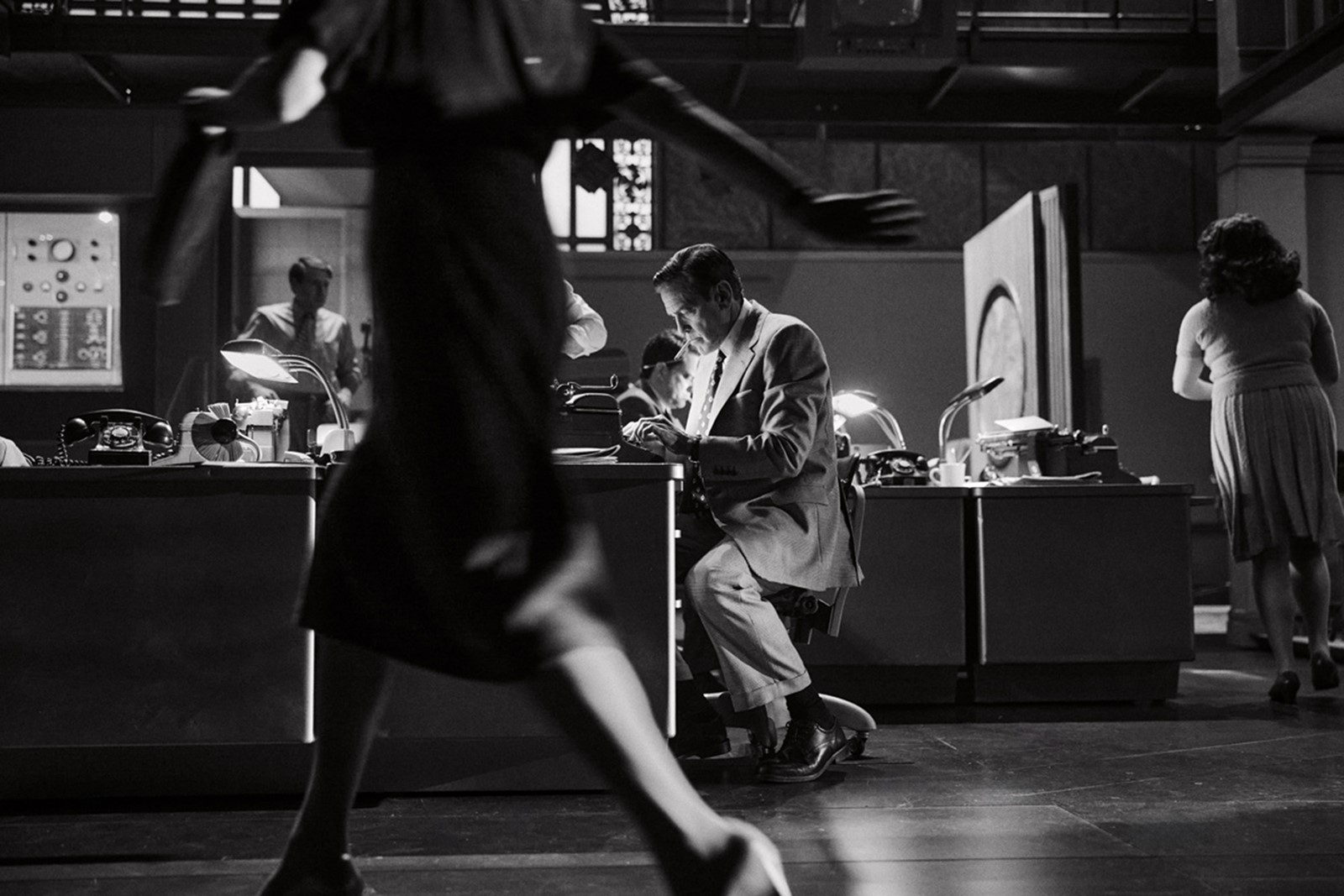
Saturday afternoon out west and evening back east, as citizens faced off against ICE agents in the streets of Los Angeles, “Good Night, and Good Luck,” George Clooney’s 2005 dramatic film tribute to CBS newsman Edward R. Murrow, became a Major Television Event, broadcast live from Manhattan’s Winter Garden Theater, by CNN and Max. That it was made available free to anyone with an internet connection, via the CNN website, was a nice gesture to theater fans, Clooney stans and anyone interested to see how a movie about television translates into a play about television.
The broadcast is being ballyhooed as historic, the first time a play has been aired live from Broadway. And while there is no arguing with that fact, performances of plays have been recorded onstage before, and are being so now. It’s a great practice; I wish it were done more often. At the moment, PBS.org is streaming recent productions of Cole Porter’s “Kiss Me, Kate!,” the Bob Dylan-scored “Girl From the North Country,” David Henry Hwang’s “Yellow Face” and the Pulitzer Prize-winning mental health rock musical “Next to Normal.” Britain’s National Theater at Home subscription service offers a wealth of classical and modern plays, including Andrew Scott’s one-man “Vanya,” as hot a ticket in New York this spring as Clooney’s play. And the archives run deep; that a trip to YouTube can deliver you Richard Burton’s “Hamlet” or “Sunday in the Park With George” with Mandy Patinkin and Bernadette Peters is a gift not to be overlooked.
Clooney, with co-star Anthony Edwards, had earlier been behind a live broadcast of “Ambush,” the fourth season opener of “ER” as a throwback to the particular seat-of-your-pants, walking-on-a-wire energy of 1950s television. (It was performed twice, once for the East and once for the West Coast.)
That it earned an audience of 42.71 million, breaking a couple of records in the bargain, suggests that, from a commercial perspective, it was not at all a bad idea. (Reviews were mixed, but critics don’t know everything.)
Like that episode, the “live” element of Saturday’s broadcast was essentially a stunt, though one that ensured, at least, that no post-production editing has been applied, and that if anyone blew a line, or the house was invaded by heckling MAGA hats, or simply disrupted by audience members who regarded the enormous price they paid for a ticket as a license to chatter through the show, it would presumably have been part of the broadcast.
None of that happened — but, it could have! (Clooney did stumble over “simple,” but that’s all I caught.) And, it offered the groundlings at home the chance to see a much-discussed, well-reviewed production only a relatively few were able to see in person — which I applaud on principle and enjoyed in practice — and which will very probably not come again, not counting the next day’s final performance.
The film, directed by Clooney and co-written with Grant Heslov (who co-wrote the stage version as well), featured the actor as producer and ally Fred W. Friendly to David Strathairn’s memorable Murrow. Here, a more aggressive Clooney takes the Murrow role, while Glenn Fleshler plays Friendly. Released during the second term of the Bush administration, the movie was a meditation on the state of things through the prism of 1954 (and a famous framing speech from 1958 about the possibilities and potential failures of television), the fear-fueled demagoguery of Wisconsin Sen. Joseph McCarthy, and Murrow’s determination to take him on. (The 1954 “See It Now” episode, “A Report on Sen. Joseph McCarthy,” helped bring about his end.) As in the film, McCarthy is represented entirely through projected film clips, echoing the way that Murrow impeached the senator with his own words.
It’s a combination of political and backstage drama — with a soupcon of office romance, represented by the secretly married Wershbas (Ilana Glazer and Carter Hudson) — even more hermetically set within the confines of CBS News than was the film. It felt relevant in 2005, before the influence of network news was dissolved in the acid of the internet and an administration began assaulting the legitimate press with threats and lawsuits; but the play’s discussions of habeas corpus, due process, self-censoring media and the both-sides-ism that seems increasingly to afflict modern media feel queasily contemporary. “I simply cannot accept that there are, on every story two equal and logical sides to an argument,” says Clooney’s Murrow to his boss, William F. Paley (an excellent Paul Gross, from the great “Slings & Arrows”). As was shown here, Murrow offered McCarthy equal time on “See It Now” — which he hosted alongside the celebrity-focused “Person to Person,” represented by an interview with Liberace — but it proved largely a rope for the senator to hang himself.
Though modern stage productions, with their computer-controlled modular parts, can replicate the rhythms and scene changes of a film, there are obvious differences between a movie, where camera angles and editing drive the story.
It’s an illusion of life, stitched together from bits and pieces. A stage play proceeds in real time and offers a single view (differing, of course, depending on where one sits), within which you direct your attention as you will. What illusions it offers are, as it were, stage magic.
It’s choreographed, like a dance, which actors must repeat night after night, putting feeling into lines they may speak to one another, but send out to the farthest corners of the theater.


 PREVIOUS ARTICLE
PREVIOUS ARTICLE
